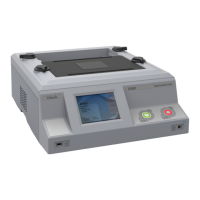C H A P T E R 7 – T E S T S A N D T E S T C O N D I T I O N S
AT5600 User Manual 98-119 issue 14 Page 123
Non-linear inductance
Normally inductance measurements should be used for transformers where the
B-H characteristics are linear.
However, if inductance measurements are attempted for instance with line
frequency transformers where the core material is non-linear even at low signal
levels, the measured results can be highly dependent on the applied test signal.
This can be a problem when trying to compare measurements made on
commercially available impedance bridges, or component testers, with
measurements made using the AT Series testers. The test signal in such bridges
is usually determined within the instrument and is often at a fixed frequency and at
a voltage level which is not guaranteed to be constant for all value of inductance.
Usually, if the actual test conditions of the bridge can be determined, and the
tester is then programmed to deliver the same test conditions across the
inductance the results will then agree. (See also the comments below on
differences caused by the choice of equivalent circuit)
Equivalent circuit
Inductance is always measured as part of a complex impedance; the result being
expressed in terms of either a series or parallel equivalent circuit. Note that, for
any given winding, the inductance values for two circuits are not necessarily the
same; this should be born in mind when specifying the test limits.

